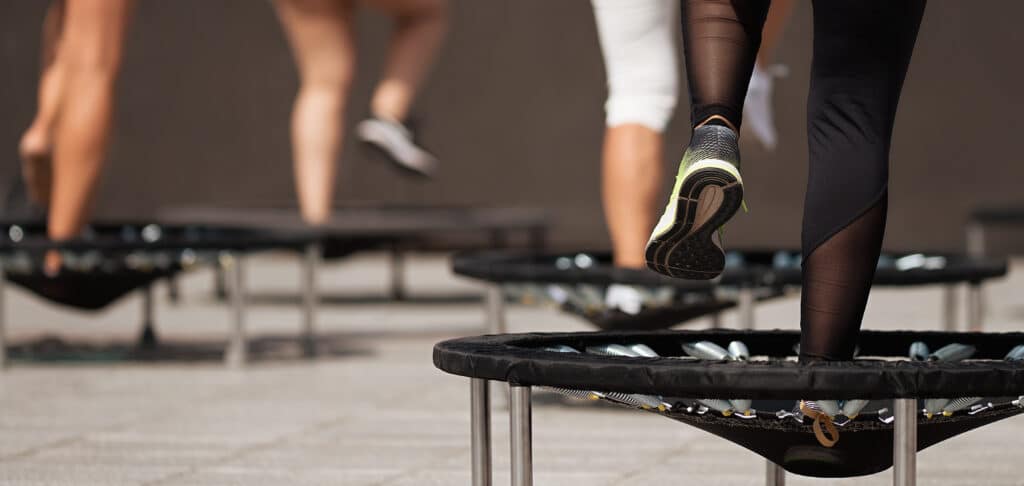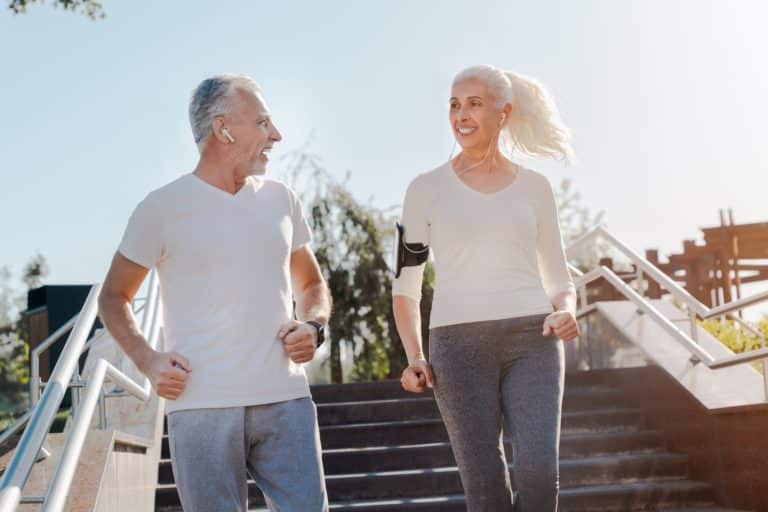Ever considered a rebounder or exercise trampoline to enhance your fitness regimen? If so, you’re probably curious about how a rebounder trampoline can boost your health.
Table of Contents
Rebounding is not just a fun way to work out— rebound exercises also have numerous health benefits. From basic bouncing to complex maneuvers like jumping jacks, twists, and kicks, the rebounder is a perfect tool for low-impact aerobic exercise.
This article delves into rebounding, its numerous health benefits, safety tips, and purchase advice. It even includes a 20-minute beginner-friendly workout you can jump into today!
Understanding Rebounding: The Fun Way to Stay Fit
Rebounding is a low-impact aerobic activity involving a mini exercise trampoline. Remember when you jumped on a trampoline in gym class, gymnastics, or at home in your backyard?
A rebounder mimics those larger trampolines with a smaller, more portable frame, making it ideal for single-user workouts. Its compact size ensures easy maneuverability and storage within your living space. A rebounder trampoline is a fantastic fitness alternative, even in a small apartment.
The principle of rebounding is simple: You perform basic jumps and bounces on the trampoline, using the springs to gain momentum and intensity.
So, why is rebounding beneficial?
Integrating an exercise trampoline into your workout routine can significantly enhance your health and well-being. It’s an activity that transcends age boundaries and is generally safe for children and older adults.
The remarkable benefits of using a rebounder:
- Enhance your speed and agility: To give you the edge in lively games with your kids or grandkids!
- Boost your cardiovascular health: Rebounding elevates your heart rate, strengthening your heart and lungs, enhancing circulation, lowering blood pressure, and mitigating the risk of heart disease.
- Improve bone density: As a weight-bearing exercise, rebounding helps decrease your risk of osteoporosis and maintain robust bones.
- Strengthen your muscles: Bouncing engages multiple muscle groups, including the legs, core, and upper body, toning and strengthening them and enhancing daily activities.
- Improve balance and coordination: Maintaining stability while performing rebounding exercises challenges your body’s balance and coordination. The unstable surface of a trampoline improves your proprioception (your body position awareness), which is crucial in reducing fall risks as we age.
- Low-impact cardio: Rebounder workouts are gentle on the joints due to the trampoline’s shock-absorbing surface. You get aerobic exercise benefits without excessive stress on your hips, knees, and ankles.
- Improve your lymphatic system: The up-and-down bouncing on a rebounder trampoline stimulates the lymphatic system, which is crucial for toxin and waste removal, enhancing your immune system and reducing swelling.
- Reduce stress: Working out on a fitness trampoline releases endorphins, the “feel-good” hormones. These mood enhancers keep you coming back for more!
- Maintain or lose weight: Incorporating rebounder trampoline workouts into your regular fitness routine is an effective way to lose or maintain weight. Sweat it out, burn calories, and boost your metabolism.
The advantages of rebounder exercises are undeniable! Remember, the key is to start slowly, gradually increasing intensity and duration to prevent overexertion or injury.
It’s always best to consult a healthcare professional like your primary care physician or physical therapist before beginning a new exercise routine, especially if you have any underlying health conditions.
How to choose the best rebounder or mini trampoline for your needs

Choosing the perfect rebounder can seem daunting, especially when you realize that not every mini trampoline is built the same. Here are a few factors to consider that can help you make an informed decision and get the most bang for your buck.
Essential features to look for in a fitness trampoline:
Safety features
Start by inspecting the frame’s sturdiness and the safety cover over the springs or padded edges. Non-slip feet can prevent unwanted trampoline movement during exercise. Robust legs are vital for stable jumps. If you need extra stability, search for a model with a handlebar for additional support.
Weight Capacity
Ensure that the rebounder you choose can securely support your body weight. While most rebounders can handle weights between 200 to 300 pounds, there are options with higher weight capacities for those who need them.
Bounce Quality
Do you prefer a springy bounce or a gentle one? Rebounders use either springs or bungee cords. Try out different models to determine your comfort level. Whichever model you select, ensure it doesn’t squeak or generate unwanted noise during exercise.
Size and Portability
Mini trampolines offer a range of sizes, typically between 36 to 48 inches in diameter. If you’re short on space, look for foldable models.
Pricing & Budget
The price range of rebounders is wide, from $75 to $500 or more. Determine your budget and explore options within that range, ensuring you do not compromise quality or safety.
Warranty and customer support
Before purchasing, check if the manufacturer provides a warranty and has a robust customer support system for potential issues during use.
All these factors will lead you to a rebounder or mini trampoline tailored to your specific needs, ensuring a safe, fun, and effective exercise routine.
A 20-Minute Beginner Exercise Trampoline Workout
Let’s dive into a 20-minute beginner-friendly rebounder workout! This session involves various exercises to stimulate different muscle groups for a holistic workout. Please remember to warm up before you begin, cool down, and stretch afterward.
Feel free to adjust the intensity and duration of each exercise to match your fitness level and comfort. Hold onto a surface or the trampoline handlebar for added stability during these exercises.
If you’ve noticed a rebounder at a physical therapy clinic, you’ll often find it inclined as a bounce-back for ball exercises. However, the routine we’ve curated for you involves the rebounder in a flat position for standing exercises. This arrangement maximizes the benefits of rebounding.
Music can be a great mood booster, so I recommend creating a playlist of your favorite tracks or listening to upbeat music on the radio during your workout to keep an element of rhythmic fun in your rebounder practice.
Warm-up (3 minutes)
- On the rebounder, march in place, lightly lifting your knee to your chest.
Basic Bounce (2 minutes)
- Bounce lightly, feet together or shoulder-width apart, leaving the mat slightly.
- Keep your core engaged and arms relaxed by your sides.
Jumping Jacks (1 minute)
- Start with your feet together and arms by your sides.
- Jump and spread your feet apart, raising your arms above your head.
- Jump back to the initial position and repeat.
High Knees (1 minute)
- March in place while lifting your knees as high as possible.
- Pump your arms as if you were running.
Squats (1 minute)
- Stand with your feet shoulder-width apart.
- Lower into a squat position by bending your knees and pushing your hips back.
- Keep your chest lifted and your weight in your heels.
- Return to the starting position and repeat.
Rebounder prancing (2 minutes)
- Keeping your feet shoulder-width apart, lightly bounce on one leg before bouncing on the other leg
- This is a similar movement to skipping in place
Alternating Lunges (1 minute)
- Step forward with your right foot, lowering into a lunge position.
- Push off with your right foot and return to the starting position.
- Repeat on the left side, alternating between legs.
Core Twist (1 minute)
- Stand with your feet hip-width apart and your arms bent in front of your chest.
- Twist your torso to the right, bringing your left elbow toward your right knee.
- Return to the center and twist to the left, bringing your right elbow toward your left knee.
- Repeat alternating sides.
Mountain Climbers (1 minute)
- Place your hands shoulder-width-apart rebounder in a plank position.
- Bring one knee toward your chest and quickly switch legs, mimicking a running motion.
- Continue alternating legs at a brisk pace.
Single-Leg Bounces (1 minute per foot)
- Bounce up and down on one foot together in the center of the trampoline, leaving the mat slightly.
- Keep your core engaged and arms relaxed by your sides.
Forward-Backward Bounce & Side-to-side Bounce (1 minute each)
Forward & Backward Bounce
- Bounce forward and backward on the trampoline with your feet together
- Keep your core engaged and arms relaxed by your sides.
Side-to-Side Bounce
- Bounce side to side on the trampoline with your feet together
- Keep your core engaged and arms relaxed by your sides.
Cool down and Stretch (3 minutes)
- Gradually decrease the intensity of your workout by returning to marching in place –
- Perform gentle stretches for your legs, arms, back, and shoulders as needed.
The Health Benefits of Rebounding for Seniors with Chronic Conditions
Rebounding offers many health benefits for older people, even those with chronic conditions.
Research indicates that balance training exercises using a mini-trampoline over three weeks improved postural control in stroke patients. The affected individuals also showcased enhanced mobility and ease in performing activities of daily living, such as dressing and bathing.
High-intensity rebounder exercises can amplify cardiorespiratory fitness, boosting heart and lung strength. However, for those who are sedentary and obese, it’s crucial to gradually elevate the intensity of these workouts to ensure the health of your cardiovascular system.
Studies illustrate that older adults performing mini-trampoline exercises experienced improved balance, functional mobility, strength, and gait performance and reduced fear of falling, especially among those with osteopenia. These individuals engaged in a 12-week intervention program comprising trampoline workouts twice weekly, each lasting 45-60 minutes. The exercise routine incorporated a blend of balance, strength, and jumping exercises on the rebounder.
Physical therapists often use outcome measures to gauge the effectiveness of their treatment and ensure patients are making progress under their care. Evidence indicates that jumping exercises yield more significant benefits than other therapeutic exercises for enhancing muscle strength and balance.
Therapists utilized measures to assess balance, dynamic posture, and leg muscle strength. The exercises were conducted for 20 minutes daily, five days a week, over four weeks. This implies that small, consistent changes can quickly result in improvements that enhance everyday function.
Rebounder Tips & Precautions for Older Adults
While rebounder workouts come with an array of benefits, it’s crucial to execute them in a manner that suits you. To ensure a safe and effective rebounding workout, here are some tips and precautions:
Choose the right trampoline
Opt for a high-quality mini trampoline explicitly designed for exercise. Seek models equipped with stability bars or handles for additional balance and support.
Warm-up and cool down
Commence each rebounding session with a gentle warm-up to prepare your body for the exercise. This could include marching in place, gentle bouncing, or stretching. Similarly, conclude your workout with a cool-down period to gradually decrease your heart rate and stretch your muscles.
Start slowly and progress gradually
If you’re a novice to rebounding or have been inactive, start with shorter sessions and low-intensity exercises. Gradually augment the duration and intensity of your workouts as your comfort level and fitness improve.
Maintain good posture
Stand tall, pull your shoulders back, and engage your core muscles while rebounding. This practice helps maintain stability and proper alignment, minimizing the risk of injuries.
Wear supportive shoes
Choose footwear that provides good cushioning and support to protect your feet and joints while rebounding.
Use the stability bar or handles
If your mini-trampoline is equipped with a stability bar or handles, utilize them for additional balance and security, particularly if you feel unstable or off balance.
Focus on controlled movements
Avoid excessive bouncing or jumping too high, which can strain your joints. Instead, aim for controlled and gentle movements, keeping your feet in contact with the trampoline surface.
Listen to your body
Be mindful of how your body feels during and after rebounding. Stop exercising and consult your healthcare provider if you experience pain, dizziness, or discomfort. If you feel exhausted or out of breath, take breaks as necessary.
Stay hydrated
Consume water before, during, and after your rebounding session to prevent dehydration.
Be aware of possible urine leakage while jumping
This condition, known as stress incontinence, is surprisingly common in older exercisers. Consider consulting a pelvic floor physical therapist who can help strengthen your pelvic floor to prevent leakage, especially during exercise.
Modify exercises if necessary
If you have specific physical limitations or concerns, adapt the exercises to suit your needs. For instance, you can decrease the range of motion or try seated exercises on the trampoline.
Rebounding exercise comes with many benefits, but it’s crucial to ensure you’re using it safely. By following these simple guidelines, you can create a routine you can stick to and enjoy safely.
Key Takeaways
- Understanding Rebounding: Rebounding is a low-impact aerobic exercise using a mini trampoline or rebounder, suitable for all ages.
- Health Benefits: Enhances speed, agility, cardiovascular health, bone density, muscle strength, balance, and coordination. It also improves lymphatic system function and helps in weight management.
- Safe & Effective: With its shock-absorbing surface, rebounding is gentle on the joints, offering a fun and low-impact cardio option.
- Choosing the Right Rebounder: Factors like safety features, weight capacity, bounce quality, size, portability, budget, warranty, and customer support should be considered.
- Special Benefits for Seniors: Rebounding helps improve postural control in stroke patients, enhances cardiorespiratory fitness, and reduces the fear of falling among older individuals.
- Tips & Precautions for Older Adults: Guidance on choosing the right trampoline, maintaining posture, wearing supportive shoes, controlled movements, listening to the body, hydration, addressing stress incontinence, modifying exercises, and taking breaks to ensure safety.
FAQs
Are there specific rebounding exercises recommended for people with certain health conditions, such as arthritis or heart disease?
For individuals with arthritis, the low-impact nature of rebounding may be beneficial. Gentle bouncing where the feet do not leave the trampoline can improve joint mobility and strength without significant stress on the joints. For heart disease patients, rebounding can help improve cardiovascular health. However, it’s essential to start slowly and gradually increase intensity as tolerated. Any new exercise regimen should be discussed with a healthcare provider first to ensure it’s suitable and safe for the individual’s health condition.
How long should one use a rebounder to start seeing noticeable health improvements?
The timeline to see health improvements from rebounding can vary depending on individual fitness levels, frequency, and duration of workouts. However, some research suggests that engaging in a regular rebounding routine for several weeks to a few months can yield noticeable improvements in cardiovascular health, balance, and muscle strength.
Is there any risk of a rebounder damaging flooring if used indoors, and are there precautions to prevent this?
Rebounders usually have rubber-tipped legs or feet to prevent slippage and protect your floors. However, placing a non-slip mat or thick rug under your rebounder could provide extra protection, particularly on delicate or wooden flooring.
Can rebounding be effectively combined with other forms of exercise like weight training or yoga?
Absolutely! Rebounding can be a fun and beneficial addition to a varied workout regimen. It can serve as a cardio session between strength training days, or you can even incorporate weights into your rebounding routine for an added challenge. Yoga can complement rebounding by stretching and relaxing your muscles after a session, which aids in recovery and flexibility.
Is having professional supervision necessary when starting out with rebounding workouts?
While it’s not strictly necessary, beginners might find it helpful to have a few sessions with a fitness professional or personal trainer to learn proper technique and get personalized advice based on their health and fitness goals. A trainer or physical therapist can ensure you use the equipment safely and effectively.
References:
- Miklitsch C, Krewer C, Freivogel S, Steube D. Effects of a predefined mini-trampoline training program on balance, mobility, and activities of daily living after stroke: a randomized controlled pilot study. Clin Rehabil. 2013 Oct;27(10):939-47. doi: 10.1177/0269215513485591. Epub 2013 Jul 1. PMID: 23818410
- Ross R, de Lannoy L, Stotz P. J. Separate effects of intensity and amount of exercise on interindividual cardiorespiratory fitness response. Mayo Clinic Proceedings. 2015 Oct;90(11):1506-1514. doi: 10.1016/j.mayocp.2015.07.024
- Posch M, Schranz A, Lener M, Tecklenburg K, Burtscher M, Ruedl G, Niedermeier M, Wlaschek W. Effectiveness of a mini-trampoline training program on balance and functional mobility, gait performance, strength, fear of falling and bone mineral density in older women with osteopenia. Clin Interv Aging. 2019 Dec 20;14:2281-2293. doi: 10.2147/CIA.S230008. PMID: 31908438; PMCID: PMC6929928
- Park J, Cho K, Lee W. Effect of jumping exercise on muscle strength and balance of elderly people: a randomized controlled trial. Journal of Physical Therapy Science. 2012 Dec(24);1345-1348. doi: 10.1589/jpts.24.1345






